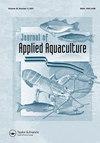The status and potential of small-scale aquaculture development in Southern Ethiopia
IF 0.8
Q3 FISHERIES
引用次数: 0
Abstract
ABSTRACT The study was conducted to assess the status, trend and potential of small-scale aquaculture production and its use as food and income sources. The study also identified the major constraints affecting the development of aquaculture and suggested possible interventions for further research and extension services in the study areas. Data was collected from a total of 300 households and presented as descriptive statistics. The present study showed that 96.7% of the total respondents were used river and stream water to fill their ponds. The study also showed that 93.4% of fish farmers were involved in pond-based aquaculture production. Relatively higher numbers of fish farmers found in Gedeo Zone (95.5%) were involved in pond-based aquaculture than found in Sidama Region (87.2%). Across the study areas, 34.7% of the respondents reported that fish production trend is increasing. The study also showed that 72.7% of the respondents reported that the absence of technologies was the first ranked constraint affecting the development of small-scale aquaculture. In conclusion, the trend of small-scale aquaculture production is increasing due to the availability of potential water resources and good types of soil used for pond-based aquaculture development. The absence of aquaculture technologies, and lack of quality fingerlings are the most prominent constrains affecting the development of aquaculture. Therefore, capacity building through training, extension, and advanced education to fish rearing households and researchers and allocation resources are crucial for successful development of aquaculture in the study areas.埃塞俄比亚南部小型水产养殖发展的现状和潜力
本文章由计算机程序翻译,如有差异,请以英文原文为准。
求助全文
约1分钟内获得全文
求助全文
来源期刊

Journal of Applied Aquaculture
Environmental Science-Ecology
CiteScore
3.20
自引率
0.00%
发文量
38
期刊介绍:
The Journal of Applied Aquaculture is a platform for the sharing of practical information needed by researchers to meet the needs of investors, farm managers, extension agents and policy makers working to adapt aquaculture theory to achieve economic and food security objectives in the real world. The journal emphasizes multi-disciplinary research and case studies that propose financially and logistically viable solutions to observable problems.
 求助内容:
求助内容: 应助结果提醒方式:
应助结果提醒方式:


